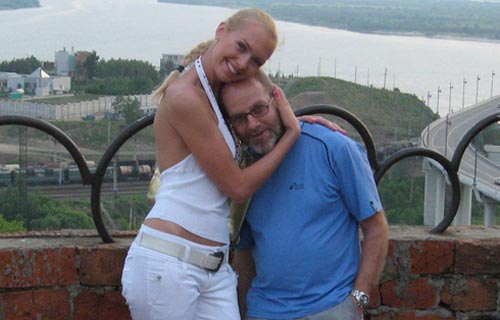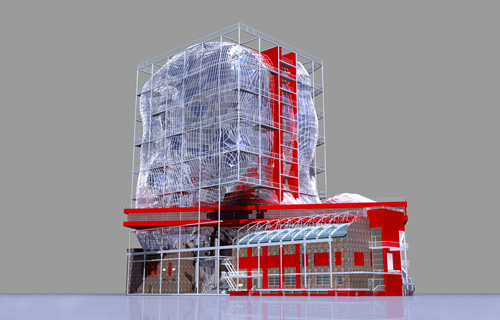OPENSPACE.RU will be bringing you monthly digests in English. This time: Russian self-representations at the Venice biennial, young art in Moscow, government plans for a new museum, and the introduction of contemporary art to regional Russia

Dmitry Gutov and Miss Far East in Khabavorsk. Russian know the bridge over the Amur in the background from 5,000 Rouble Notes
The summer kicked off with the Venice Biennial, where the Russian presence was overwhelming. "Nobody has such a nice pavilion as we do," OPENSPACE.RU Art section editor-in-chief Ekaterina Degot assures us in a video-tour of the Russian pavilion, "nobody has such a nice view of the lagoon. Nobody has such a big banner with so many nice logos; in fact, there are even two banners on the outside, and another one inside. And nobody except for us managed to stuff seven huge installations into such a cramped space." The tone of this introduction mocks the triumphalism of the opening party, during which Degot asks photographer Boris Mikhailov what he thinks. "Everything is beautiful," he enthuses. "So everything is good." "Beautiful is not necessarily good," answers Mikhailov, explaining that all this shiny beauty hides something Russians don't like to see. Have a look below to practice your Russian.
Degot's "Letter from Venice: A Russian Bride Dreams of Happiness" continues in this critical key. Departing from a linguistic lapse that Russian Minister of Culture Avdeev made during his opening speech, where he confused the Italian l’esposizione russa with la sposa russa, or the Russian bride, Degot launches into a scathing polemic with the Russian elite's hunger for self-representation. The Russian presence at the Venice Biennial was a lot like a wedding, she says, with most of the guests oblivious to who was actually getting married: "black walls, spotlighting like in a disco: this is what we like! As one visitor said while leaving one of this year's many Russian receptions: Your art is very bad, but your parties are great." Degot extends this diagnosis to the various curatorial projects extends from the Russian pavillion to collateral projects such as Alexandra Markvo's "Unconditional Love" and Stella Foundation's "That Strange Object of Art," as well as the numerous presentations of earlier biennial participants. One of the reasons for the almost phantasmagoric quality of all these displays, according to Degot, is that the role of the curator is misunderstood as that of a PR manager, and not as that of a researcher, writer or artist, a status that has become popular to an unhealthy extent among certain ladies (especially) and gentlemen.
The Rebirth of Young Critical Art?
Far from the lagoon, a new generation of younger Russian artists has been emerging in Moscow, Petersburg, and elsewhere, though this process has been arduously slow, as Russia is still missing an educational system for contemporary art as well as the necessary support structures to help artists to develop their practices. So every showing of work that does not conform to the glamorous mainstream is a breath of fresh air.
One of these projects was a group exhibition at project_fabrika, a Moscow paper factory that hosts cultural projects in its defunct shop floors. Curated by up-and-coming artist Arseny Zhilyaev, it bore the intriguing title "Natasha and the Machine." As Zhilyaev explains in OPENSPACE.RU's video from the opening, the site-specific work here narrates the story of a woman called Natasha who operated a paper-producing machine. Have a look at the video to see the work, and if you don't speak Russian, feel free to turn off the sound.
Newcomer Mikhail Lylov went to an abandoned factory deep in the Russian provinces and singlehandedly tried to rebuild the industry there. Anna Titova made a small work about the fate of Matthias Rust (remember him?), while artist and educator Stas Shuripa contributed a large paperwork on a secret Soviet-era photocopying plant. The centerpiece of the show was a video by Zhilyaev and Titova, in which they try to shake hands with Natasha, the worker. This performative note resists the gravity of a designerish neo-minimalism that pervades much of the work, and this carries over into an open-ended, romantic-performative discourse on immaterial labor. One could see some of this in a panel discussion in which curators, critics, artists, and media professionals discussed whether or not the "creative industries" were a social reality or a ideological utopia in Russia today. This discussion was mirrored by a comment war, in which two factions emerged: one that saw this sort of art as intolerably boring, and another that defended its low-key seriousness and its willingness to engage romantic metaphors.
Less than a week after this opening, the more glamorous Regina Gallery presented a group exhibition called "Occupied City," collectively curated by a group of young artists, who explained their work in a video tour on OPENSPACE.RU. Alexandra Galkina said that the exhibition aimed for a decisively politico-aesthetic critique of the disciplinary measures and zones of control created by ubiquitous security organs in Moscow, a city where new class relations are rigidly enforced. Her own contributions were frotages of official signs at the entrances of security buildings, made at a considerable risk of arrest. Zhanna Kadyrova showed quasi-minimalist sculpture of tiles, smashed and mended to suggest solidified urban violence. Activist and artist Ilya Budraitskis presented official letters of denial for requests to sanction protest meetings and demonstrations. David Ter Oganian's drawings on the disciplinary measures in the city spilled out into urban space surrounding the Winzavod Culture Center. In parallel, Galkina has been collaborating with Nastya Ryabova to make an extensive web-based drawing project called Megazine.biz.
A New Museum?

Pre-project proposal for the definition of the general city-planning paramets of the NCCA museum complex. (Authors: Mikhail Khazanov Studio, M. Mindlin, A. Nagovitsin)
On July 24th, just as Moscow was settling down for its summer vacation, Deputy Minister of Culture Pavel Khoroshilov and director of the National Center for Contemporary Art Mikhail Mindlin dropped a bomb by announcing plans for a new museum dedicated exclusively to contemporary art. The first of its kind in Moscow, it would be literally build on the the structure of the NCCA and its collection. Several days later, the Ministry of Culture announced that it had set aside "a sizeable sum" to buy works by Damien Hirst, and Jake and Dinos Chapman. This provoked immediate discussions in the Russian blogosphere.
OPENSPACE.RU responded by asking artists, curators, and art dealers how they saw the future of this museum, and what they would want this future to be. Media art veteran Alexei Shulgin says that the NCCA is likely to become a space for supershows and megaexperiences if it follows the route set out by the Guggenheim or even the Centre Pompidou, while young Moscow artist and critic Diana Machulina is wary of the influence that gallery business might have on the collection. Curator Viktor Misiano sees the NCCA's evolution into a museum as logical, since this institution is already academic, while Chto delat artist Nikolai Oleinikov hopes the NCCA museum will be "both popularizing project and discursive laboratory" following the lead of museums like the Reina Sofia in Madrid, the MAK in Vienna or the Vanabbe Museum in Eindhoven, rather than "matrioshka monsters" like the Guggenheim.
One of the most interesting moments is that the NCCA/Ministry of Culture announcement is but one of many museum projects that have been announced over the last two years, adding a host of virtual institutions to the already existing exhibition halls of Moscow. Viktor Misiano points out that this situation is not unique to Russia, but has surfaced all over the world as the result of neo-liberal transformations and rapid accumulations of capital. He notes that private institutions are often more energetic and mobile, and that one could accuse the NCCA of tiredness. Then again, he warns, private capital often behaves irresponsibly and tends to discredit the notion of the museum, buying itself immunity from criticism by investing into the art scene and thus buying its silence. This is something the art community must collectively prevent, argues Misiano.
Contemporary Art for the Regions

Dmitry Gutov and Miss Far East in Khabavorsk. Russian know the bridge over the Amur in the background from 5,000 Rouble Notes
Victor Misiano's cutting assement of the museum-situation in Moscow could also be applied to efforts to bring contemporary art to the more far-flung of Russia's regions, where the NCCA branches have recently been joined by private initiatives. These include a traveling exhibition organized by Pierre Brochet called "New Rules" (spring-summer 2008), as well as gallery owner Marat Guelman's efforts to build a Museum of Contemporary Art in the city of Perm. The NCCA also continues to organize initiatives, such as the Art Zavod festival in Ekaterinburg, but it could easily fold to the pressure of competing with private institutions.
Though it was written more than a year ago, one of the most interesting account of contemporary art as it reaches the regions comes from artist Dmitry Gutov, who was travelled to Chabarovsk as a part of the show organized by Pierre Brochet. He says that he was shocked not only by the grueling rhythm of press conferences and tv interviews that made him feel "like Sharon Stone," but also by the seriousness of local interest in contemporary art, both on the part of the elites ("The local minister of culture wants to build a museum") and the general public, which was most concerned with "theoretical questions: what are the criteria for judging contemporary art? How do you tell art from non-art? <...> There was not one single question about money."
One of the most important hotspots of development over the last year has been Perm, where Marat Guelman has been converting a defunct Stalin-era passenger shipping terminal into a museum of contemporary art. Guelman enjoys the support of the local elite, who sees the museum as part of a broader "culturalization" strategy for the city and the region. As part of the Dyagelev Seasons in May 2009, the city organized a festival called "Living Perm." OPENSPACE.RU hosted two panel discussions at Guelman's Perm Museum of Contemporary Art, one on the future of young art, the other on the development of institutions. Ekaterina Degot also contributed to the festival as a curator, collaborating with artist Leonid Tishkov on "Kudymkor is the Locomotive of the Future," a fictionalizing curatorial narrative about the obscure local early avant-garde artist Pyotr Subbotin-Permyak. This exhibition will be shown at PROUN Gallery at Winzavod in Moscow during the Third Moscow Biennial for Contemporary Art.
In August 2009, David Riff also had a chance to see how contemporary art was being introduced to the most important economic hub of the Ural region, the city of Yekaterinburg. You can read a more detailed text in English on this trip here.
Stayed tuned for English language coverage of the Third Moscow Biennial!
- 29.06Московская биеннале молодого искусства откроется 11 июля
- 28.06«Райские врата» Гиберти вновь откроются взору публики
- 27.06Гостем «Архстояния» будет Дзюнья Исигами
- 26.06Берлинской биеннале управляет ассамблея
- 25.06Объявлен шорт-лист Future Generation Art Prize
Самое читаемое
- 1. «Кармен» Дэвида Паунтни и Юрия Темирканова 3450278
- 2. Открылся фестиваль «2-in-1» 2340549
- 3. Норильск. Май 1268474
- 4. Самый влиятельный интеллектуал России 897657
- 5. Закоротило 822070
- 6. Не может прожить без ирисок 781980
- 7. Топ-5: фильмы для взрослых 758542
- 8. Коблы и малолетки 740808
- 9. Затворник. Но пятипалый 471059
- 10. Патрисия Томпсон: «Чтобы Маяковский не уехал к нам с мамой в Америку, Лиля подстроила ему встречу с Татьяной Яковлевой» 402956
- 11. «Рок-клуб твой неправильно живет» 370382
- 12. ЖП и крепостное право 345038
